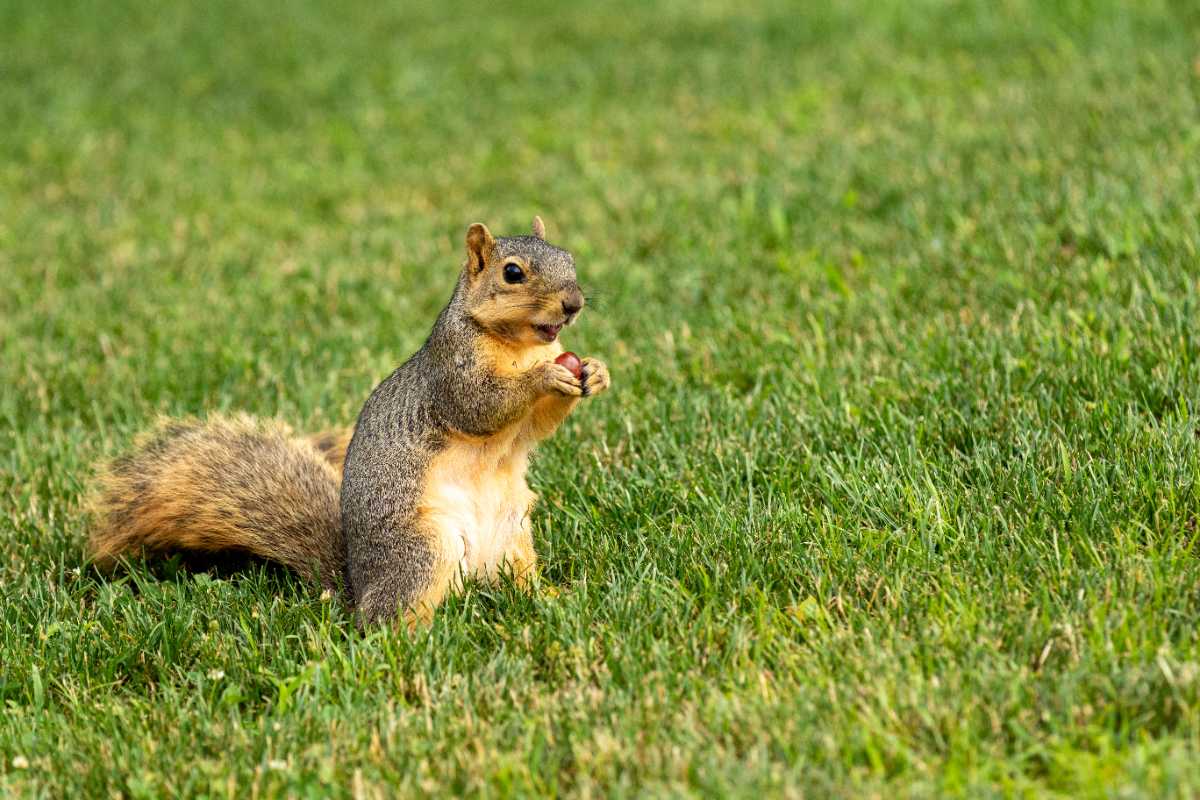
Squirrels will raid your bird feeders, dig up your lawn, devour your fruits and veggies, and strip bark from your trees during harsh winters. They’re intelligent, persistent, and difficult to control.
The most effective approach is to combine multiple wildlife control methods, including removing their food sources, installing wire cages and tree collars, and applying repellents. Since squirrels adapt quickly, you’ll need a variety of tactics at your disposal.
In this guide, we’ll tell you how to stop squirrels from destroying your yard — and which methods work best.
- Eliminate Food Sources that Attract Squirrels
- Block Access to Nesting Sites
- Protect Plants and Trees with Barriers and Covers
- Try Natural Repellents (with Realistic Expectations)
- Chemical Repellents
- Landscape Your Yard to Discourage Squirrels
- Install Automatic Sprinklers to Keep Squirrels Out
- Hire a Professional for Trapping and Removal
- FAQ
Eliminate Food Sources that Attract Squirrels
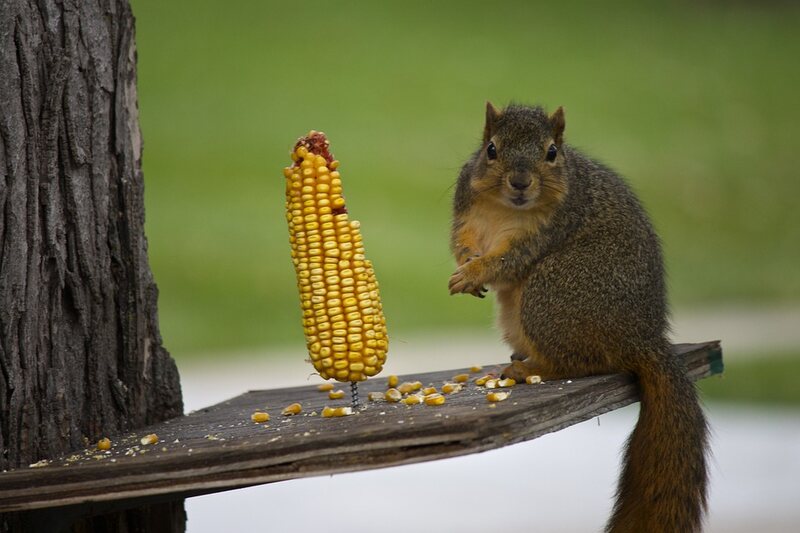
Why are squirrels digging in your yard? They have food nearby to bury. Squirrels are smart and practical. If they’re targeting your yard more than your neighbors’, it’s because food and shelter are more easily available on your property.
Removing their food source is “the single most effective and humane thing you can do,” says Sabrina Kong, DVM, a practicing veterinarian at Jules Veterinary Center in Tracy, California. Here’s what to do:
- Rake and remove fallen fruits, nuts, and acorns daily, or as often as possible.
- Cover garbage cans and compost bins with a tight lid.
- Keep pet food sealed and in your garage.
- Remove your bird feeder or install baffles to prevent squirrels from accessing the seeds.
Kong has dealt with squirrels herself and says consistency is key. “I had to get a truly squirrel-proof bird feeder and become obsessive about picking up fallen fruit from our trees.”
Squirrels outsmart most bird feeder defenses, but a few methods still work well: conical baffles, slinkies, and feeders that shut when squirrels climb on.
The food removal tactic needs some time to show results. “It takes a week or two, but once they realize the all-you-can-eat buffet is closed, they’ll move on,“ says Kong.
Block Access to Nesting Sites
Ground squirrels make their burrows underground and prefer sheltered areas that protect them from predators. To limit their nesting options on your property:
- Remove piles of leaves, branches, and other debris from your lawn.
- Install a buried hardware cloth fence around your deck or patio to prevent squirrels from gaining access under the structure.
Here’s a video with tips on how to animal-proof a patio and keep squirrels from nesting underneath:
Tree squirrels prefer to nest in tree nooks, but they’ll also build nests in your home’s gutters, soffits, eaves, chimney, walls, or attic. To limit their nesting options:
- Seal all holes and gaps with metal flashing or hardware cloth.
- Install squirrel-proof caps on chimneys and wall vents.
- Fit the gutters with gutter guards.
- Trim branches leading to the roof. “You want to create at least a 6-foot gap,” says Kong.
Protect Plants and Trees with Barriers and Covers
Squirrels love digging for freshly planted seeds and bulbs, as well as foraging for juicy seedlings. They’ll also climb fruit trees and eat apples, peaches, and other tasty fruits. Come winter, they might even target their juicy bark.
The best way to protect your plants is to install physical barriers.
Collars and Nets for Trees
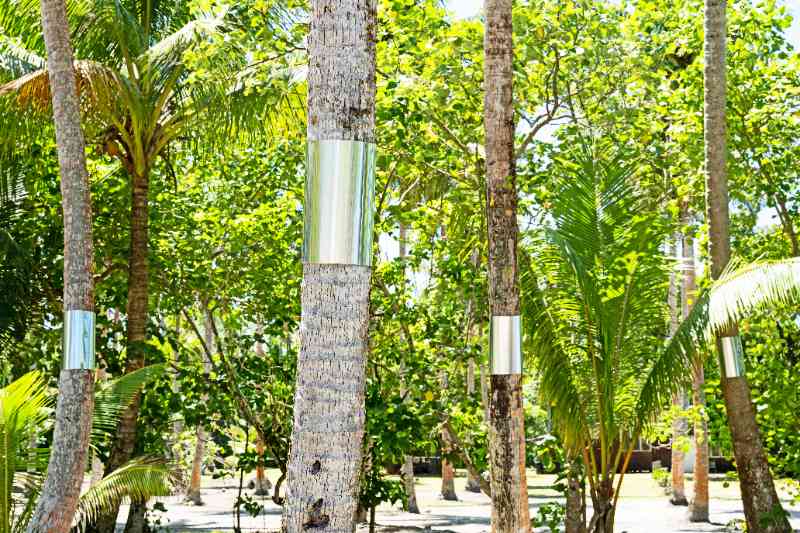
Tree collars wrap around the trunk to create a slippery barrier that squirrels can’t climb. You can buy these baffles online or make your own with a 2-foot-wide metal or plastic sheet, wires, and springs (or duct tape).
- Wrap the sheet around the trunk, 6 to 8 feet off the ground, securing the top and bottom with wire and springs (the springs allow for growth) or duct tape.
- Check the collar at least once per season to ensure it’s not choking the trunk.
Pro Tip: Avoid securing the collar with nails or screws. They harm the tree.
Tree collars work only if the squirrels can’t reach the branches by jumping from nearby trees or climbing low limbs, so:
- Prune neighboring trees so branches are at least 8 feet apart.
- Remove any branches within 6 feet of the ground.
If jumping is unavoidable (from roofs, fences, or power lines), use bird netting instead.
Drape it over the entire tree and anchor it with landscape stakes or rocks.
See Related:
- What Tools Do You Need to Trim Trees?
- Trimming Trees on a Property Line: What Are Your Rights? Your Neighbor’s?
Wire Barriers for Garden Beds
How can you keep squirrels from digging in your yard? For the garden bed area, the best tactic involves hardware cloth or chicken wire (with a 2-inch mesh or smaller opening). It’s not very pretty, but it works.
Build a wire cage over your garden beds — a simple fence won’t work since they’ll just jump in.
- If it’s tree squirrels you want to keep away, bury the wire a few inches deep into the ground.
- If they’re ground squirrels, bury the wire at least 2-3 feet deep to stop them from tunneling under.
See Related:
Wire Baskets for Bulbs
Got squirrels around the yard? Then, planting bulbs in the fall without some squirrel-proofing is a risky bet. They love munching on juicy bulbs — especially tulips. The best way to protect them is with wire.
A sure way to keep all squirrels away is a bulb cage.
- Shape chicken wire into a loose basket around each bulb (a softball works well as a mold).
- Plant the basket, pushing in enough soil to keep the bulb centered away from the wire mesh.
This works for tree squirrels digging from above and ground squirrels burrowing underground. If you’re sure the culprits are tree squirrels, you can simply secure the soil surface with hardware cloth.
- Place a piece of 1/2-inch hardware cloth over the planted area.
- Stake it down, and cover with a thin layer of soil or mulch.
Pro Tip: The University of Florida advises extending the cloth at least 1 foot in each direction beyond the edge of the planted zone.
Here’s a video showing how to animal-proof your plant bulbs to keep them safe from squirrels:
Try Natural Repellents (with Realistic Expectations)

While natural repellents won’t help you get rid of squirrels from your yard for good, they can temporarily protect valuable areas. Common options people use include:
- Cayenne pepper
- Peppermint oil
- Garlic
- Vinegar
- Blood meal
- Coyote or dog urine
Do these natural squirrel repellents work? Think of natural repellents as a first line of defense alongside more reliable methods such as physical barriers and food removal.
They work temporarily for some homeowners but rarely provide long-term results. Squirrels often get used to smells, and rain washes away most treatments within days.
Chemical Repellents
Commercial squirrel repellants are widely available but deliver mixed results. Most formulas are based on capsaicin (the compound that makes chili peppers hot), peppermint oil, castor oil, garlic, predator urine, blood meal, and egg solids.
Like natural repellents, they are more effective when used as part of a multi-method approach rather than as standalone solutions. The good news is that most will also repel chipmunks, raccoons, rabbits, and skunks.
See Related: How to Get Rid of Rabbits
Landscape Your Yard to Discourage Squirrels
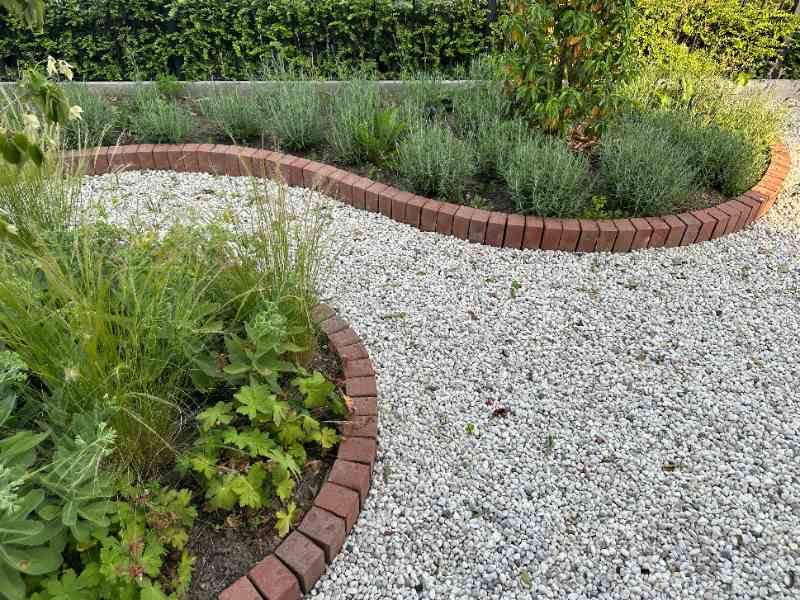
There are also a few changes in your landscape you can make to get rid of squirrels from your yard, or at least discourage them from going in certain areas.
- Space fruit trees far apart so squirrels can’t jump between them — this makes tree collars more effective. Prune regularly.
- Cover landscaping beds with gravel where possible — squirrels don’t like it.
- Plant squirrel-deterrent plants: Interplant onion, garlic, mint, marigolds, and mustard with your vegetables. Add daffodils, geraniums, hyacinths, and lily-of-the-valley to flower beds.
- Maintain a tidy, open lawn to make it easier for natural predators (owls, hawks) to hunt. Remove unnecessary shrubs and small trees, keep grass short, and trim overhanging hedge foliage.
| Keep squirrels at bay with regular yard maintenance. Hire a LawnStarter pro for bush trimming — most jobs cost around $88 per visit (average rating: 4.15 stars). |
Install Automatic Sprinklers to Keep Squirrels Out
Motion-activated sprinklers are an effective and humane deterrent — and Kong’s “favorite trick.” Install them in areas you want to protect from squirrels (lawn, garden bed, nearby trees).
“It’s completely harmless, but a sudden burst of water is a very effective and, frankly, entertaining way to teach them that your yard is not a peaceful place to hang out. It works wonders,” says Kong.
That’s how you stop squirrels from digging in your yard, especially in areas you can’t wrap in wire, like lawns.
Best for: Areas your family doesn’t frequently use. Otherwise, you’ll need to turn them off when you’re outside to avoid getting wet.
Hire a Professional for Trapping and Removal
If squirrels cause serious damage to your yard or get inside the house, you may need to trap and remove them. The best approach is hiring a licensed wildlife control professional — you’ll avoid dangerous bites and the complicated process of proper relocation.
Know the Laws Before You Trap
Many states, including Massachusetts, Connecticut, Rhode Island, and New Jersey, require permits for trapping squirrels. Even more states have banned relocating trapped wildlife entirely, including California, where Kong resides.
“But beyond the legality, it’s incredibly cruel,” says Kong. Relocation is harder on squirrels than most people realize. “You’re essentially dropping a stressed animal into a new, unfamiliar territory where it has no food, water, or shelter, and it will likely not survive,” says Kong.
“The only humane and effective solution is to call a licensed wildlife control professional who can address the problem safely and legally,” she concludes.
If You Choose to Trap Squirrels Yourself
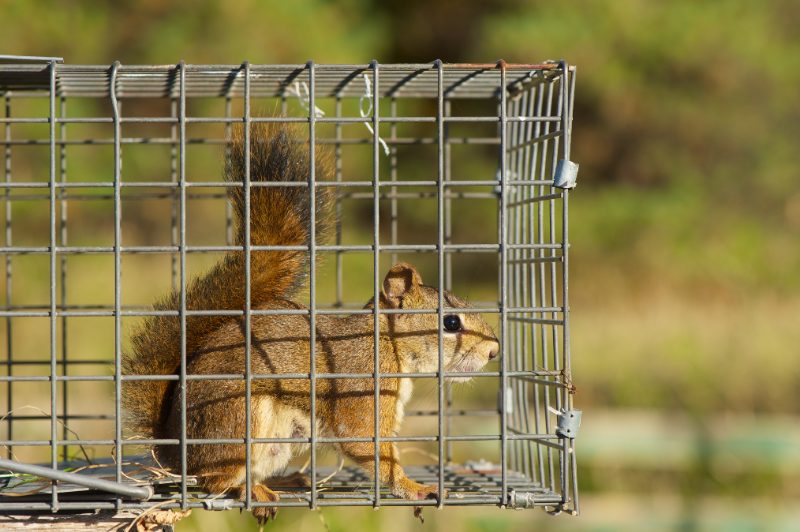
Many homeowners prefer handling yard issues themselves. If you decide to trap squirrels, do it safely for both you and the squirrel:
- Check the local laws to confirm trapping is legal in your area.
- Use a live cage trap at least 16 to 25 inches long.
- Place the trap strategically in areas where you’ve seen squirrel activity.
- Bait with peanut butter or nuts at the far end of the trap.
- Check traps every few hours to minimize stress on captured animals.
- Contact a wildlife control specialist to relocate the squirrel to a suitable location.
Wear thick gloves when retrieving traps. Squirrels can carry diseases such as rabies, salmonellosis, tularemia, and ringworm, which they can transmit through scratches and bites.
FAQ
Squirrels won’t kill an entire lawn like a fungal disease or grubs can, but they can kill the grass on small patches by damaging the roots with their digging.
Signs that indicate squirrels are more likely than other pests include:
• Multiple small, conical holes in the same area.
• Twig pruning: Freshly cut branch tips with green leaves lying on the ground in the fall.
• Leftovers: Remnants of acorn shells, cores of pine cones.
Although they might not outweigh the damage, squirrel presence comes with some benefits:
• They plant free trees: Squirrels don’t find all their buried nuts and seeds, and some germinate and grow into trees like oaks or walnuts.
• Squirrel digging aerates the soil
• They eat insects, larvae, and grubs, helping with pest control.
Keep a Squirrel-Resistant Yard
The first step to stop squirrels from destroying your yard is keeping it neat and tidy. It’s a lot of work, so it’s better to hire a pro. Find a LawnStarter lawn care pro nearby to ensure your lawn is always tidy and free of debris.
Our pros can also help with bush trimming, tree trimming, and leaf removal.
Sources:
- “Bark Stripper Squirrels.” By Joe Boggs, assistant professor. The Ohio State University.
- Dr. Sabrina Kong, DVM, Jules Veterinary Center in Tracy, California, and staff veterinarian at WeLoveDoodles. Personal interview.
- “How to Use Deterrents to Stop Damage Caused by Nuisance Wildlife in Your Yard.” By Holly K. Ober, professor and Extension specialist, Department of Wildlife Ecology and Conservation, and Arlo Kane, regional coordinator of the Landowner Assistance Program for the Florida Fish and Wildlife Conservation Commission. UF/IFAS Extension.
- “Managing Nuisance Animals and Associated Damage Around the Home” By Craig A. Harper, professor of Wildlife Management and Extension wildlife specialist, and Aubrey L. Deck, Extension specialist. University of Tennessee.
Main Image: Squirrel eats a nut in a yard. Photo Credit: Jennifer / Adobe Stock